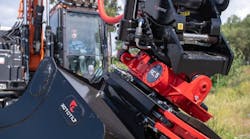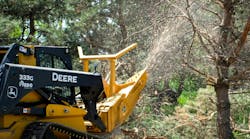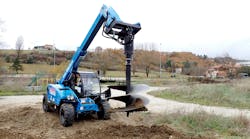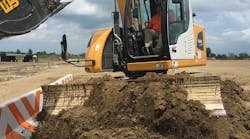Historians and archeologists have long theorized about the process used by the Egyptians to excavate and transport the millions of blocks
Bryce Cooper is the son of Billy Cooper, who pioneered automated wet saw technology. to their final destination. Amidst all the speculation however, Bryce Cooper is certain of one thing. “All I can say is that it's a lot easier today than it was back then,” he says.Cooper, along with partners Matthew and Micah Flippen, owns Cooper Stone Corporation, located on a 300-acre parcel of land in the Texas hill country near the town of Jarrell. Stone is abundant here; nearly a hundred quarries are located within a 50-mile radius. Cooper's father, the company founder, started cutting stone here in the early 1970s. Since then Cooper Stone has produced several thousand tons of quality stone.
Cooper's father is credited with pioneering the automated wet saw, a device now used by the majority of U.S. stone quarries to transform huge stone blocks into a material of usable size. The saw allowed for smooth cuts to be performed on stone at a rapid pace, a process that has greatly enhanced the efficiency of the cutting process.
Envisioning a Better WayPerhaps more significant to the process than the wet cutting saw was the senior Cooper's vision of how a trenching attachment, originally designed by Vermeer Corporation of Pella, IA, could be used in the initial excavation process. After witnessing the Vermeer rockwheel attachment in operation by a local utility company, a machine used for digging trenches through rock-laden terrain to install underground cable and pipelines, the elder Cooper got an idea. He went off to San Antonio in pursuit of the machine that has since revolutionized stone cutting.
The rockwheel made stone more affordable to produce and ultimately helped increase demand as a construction material. “The rockwheel has made cutting stone a more efficient process,” Cooper says. “The only tool available before was slow, cumbersome and expensive to operate. It just wasn't a feasible way to produce the variety of stone products we envisioned providing our customers. The rockwheel made stone more affordable to produce and ultimately helped increase demand as a construction material.”“The rockwheel was originally designed to cut trenches,” Cooper says. “What we needed was a machine capable of slicing a thinner cut. Vermeer responded by stepping up design modifications to deliver a product that fit this specific application. It streamlined the production process and allowed us to expand our product offerings.”
Cooper's father purchased his first Vermeer tractor with rockwheel attachment in 1980, a machine that served as the workhorse of this family operation for nearly 25 years. It was recently retired to a permanent site amidst the trees and native Texas wildflowers on a spot adjacent to the quarry and replaced by a newer Vermeer model – the T555. According to Cooper, the 185-horsepower, Tier 2 engine of the T555 powers the specially designed rockwheel attachment through the tough Texas stone with ease, and the auto-tilt track feature makes operating it a breeze.
Production SkyrocketsBefore the rockwheel, the only equipment available produced blocks inconsistent in size, necessitating a second cut to reduce the blocks to a size capable of being split. Varying depths and differing characteristics of each layer also presented a challenge.
“The rockwheel allows us to produce a cut that is predominately consistent in size,” Cooper says. “This greatly enhances the quality of the final product because we can alter the depth of the cut relative to the thickness of each layer. The old method restricted our ability to do this so we had more waste. With the rockwheel we can cut the differing layers separately, making a more consistent final product.”
The rockwheel has also increased production efficiency. “Before the rockwheel, we were running three to five track loaders to get out upwards of 100 tons a day,” Cooper says. “Today we can produce over 500 tons in the same amount of time. The initial cut is the most expensive part of the process, and the rockwheel has reduced the time and labor necessary to get those first blocks out of the ground.”
Production at Cooper Stone easily reaches 500 tons per day, up from only about 100 tons per day before the invention of the wet rockwheel.More Affordable Stone“The increased efficiency of the rockwheel made it possible to produce more stone for less cost, rivaling the price of competitive materials such as brick and fabricated 'fake' stone,” Cooper theorized.
“There was a time when stone was used only for the more affluent building projects because of cost,” Cooper says. “Only the really high-end projects were made of stone, and even then, usually only in areas that were near where quarries were located. We have since seen demand for stone increase significantly, both for residential and commercial uses, and now we ship stone all over the country.”
“We mix and match different types of stone based on color and physical properties for a variety of applications,” Cooper says. “All of the combinations we offer are naturally occurring stone, the only variables being composition and color.” Cooper Stone has developed products for landscaping projects, patios and retaining walls, as well as for interior projects such as fireplaces, widow sills and columns.
The Vision Takes RootAt the time when the visionary patriarch of Cooper Stone first began using the rockwheel, there were a mere handful of local quarries in existence. That number has since exploded, due in large part to the adoption of the rockwheel. Once word spread of how Cooper was using the rockwheel to cut stone, other quarry operations quickly jumped on the bandwagon. Despite the increased competition, Cooper is devoutly proud of his father's vision, and credits Vermeer Corporation for dedicating the resources to enhance the engineering and design properties of the rockwheel specifically for this application.
“We have been able to expand our business well beyond what I ever imagined,” Cooper says. “And with the resources we have, my great-great-great grandson could still be operating on this very spot. If you're still around then, stop on by and check it out for yourself.”
The Egyptians would have been ecstatic.
| Author Information |
| Randy Happel is a features writer for Two Rivers Marketing. |




